
Melanthieae is a tribe of flowering plants within the family Melanthiaceae. Molecular phylogenetic studies in the 21st century have resulted in a large-scale reassignment of many of its species to different genera; in particular the genus Zigadenus (deathcamases) has been restricted to a single species, Zigadenus glaberrimus. Plants contain alkaloids, making them unpalatable to grazing animals; many are very poisonous to both animals and humans.

Toxicoscordion venenosum, with the common names death camas and meadow death camas, is a species of flowering plant in the family Melanthiaceae. It is named for its well known toxic qualities with its common names and scientific name referencing this. Because its nectar is also poisonous, it is mainly pollinated by the death camas miner bee, which specializes collecting the toxic pollen for its young. It is native to western North America from New Mexico to Saskatchewan and west to the Pacific Ocean.
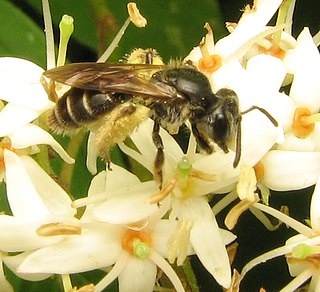
The term oligolecty is used in pollination ecology to refer to bees that exhibit a narrow, specialized preference for pollen sources, typically to a single family or genus of flowering plants. The preference may occasionally extend broadly to multiple genera within a single plant family, or be as narrow as a single plant species. When the choice is very narrow, the term monolecty is sometimes used, originally meaning a single plant species but recently broadened to include examples where the host plants are related members of a single genus. The opposite term is polylectic and refers to species that collect pollen from a wide range of species. The most familiar example of a polylectic species is the domestic honey bee.
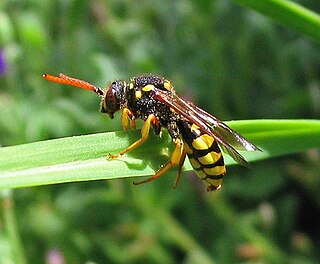
With over 850 species, the genus Nomada is one of the largest genera in the family Apidae, and the largest genus of cuckoo bees. Cuckoo bees are so named because they enter the nests of a host and lay eggs there, stealing resources that the host has already collected. The name "Nomada" is derived from the Greek word nomas, meaning "roaming" or "wandering."

Andrena is a genus of bees in the family Andrenidae. With over 1,500 species, it is one of the largest genera of animals. It is a strongly monophyletic group that is difficult to split into more manageable divisions; currently, Andrena is organized into 104 subgenera. It is nearly worldwide in distribution, with the notable exceptions of Oceania and South America. Bees in this genus are commonly known as mining bees due to their ground-nesting lifestyle.

Anticlea elegans, formerly Zigadenus elegans, is also known as mountain deathcamas, elegant camas or alkali grass. It is not a grass, but belongs to the trillium family, Melanthiaceae.
Deathcamas or death camas refers to several species of flowering plant in the tribe Melanthieae. The name alludes to the great similarity of appearance between these toxic plants, which were formerly classified together in the genus Zigadenus, and the edible camases (Camassia), with which they also often share habitat. Other common names for these plants include deadly zigadene, hog potato and mystery-grass.
Andrena salicifloris, or the willow flower miner bee, is a miner bee in the genus Andrena. Another common name for this species is the willow mining bee. The bee ranges from Colorado to California and north to British Columbia, and often inhabits arid and alpine lands. The bee is often black or dark brown, and is sparsely coated with grayish hair on the thorax, legs and on the abdomen. The pollen basket is on most of the hind leg. The wings of the willow flower miner bee are smokey, and their veins are black.

Zigadenus is a genus of flowering plants now containing only one species, Zigadenus glaberrimus, the sandbog death camas, found in the southeastern United States from Mississippi to Virginia. Around 20 species were formerly included in the genus, but have now been moved to other genera.

Toxicoscordion paniculatum is a species of flowering plant known by the common names foothill deathcamas, panicled death-camas, and sand-corn. It is widely distributed across much of the western United States, especially in the mountains and deserts of the Great Basin region west of the Rocky Mountains. It grows in many types of habitats, including sagebrush plateau, grasslands, forests, and woodlands, etc.

Andrena agilissima is a species of mining bee. They are present in most of Europe, the Near East and North Africa and can be found from April through July. Andrena agilissima is an oligolectic species, feeding only on the pollen of a few genera of Cruciferous vegetables.
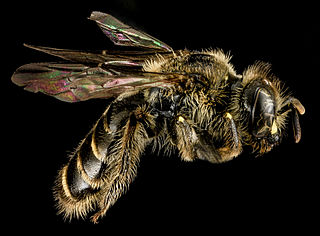
Calliopsis is a genus of panurgine bees in the family Andrenidae. There are over 80 described species distributed throughout the western hemisphere.
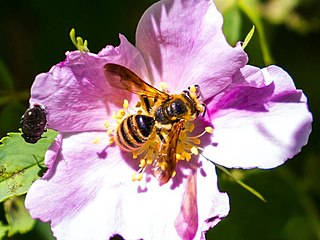
The golden-haired miner bee is a species of miner bee in the family Andrenidae. The female bees are 8 to 10 mm in length, and males are 6 to 9 mm long. It is found in the western United States, and is relatively rare outside California. It looks very similar to the death camas miner bee but is smaller.
The shiny-blue sculptured miner bee is a species of miner bee in the family Andrenidae. It is found in North America.
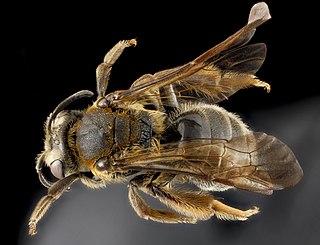
The Appalachian miner bee is a species of miner bee in the family Andrenidae. Another common name for this species is Alleghany andrena. It is found in North America. Its nests typically only have one or two cells. Adults overwinter in soil.

The two-spotted miner bee is a species of miner bee in the family Andrenidae. It is found in Central America and North America. Members of the species have communal nests made of many cells. They live in desert scrub habitat. Their primary host plants belong to the genus Helianthus.

Andrena prunorum, otherwise known as the purple miner bee, is a species of solitary bees in the family Andrenidae. It is commonly found in the continental United States as well as much of North and Central America. Andrena prunorum is a spring-flying, ground-nesting bee that serves as a ubiquitous generalist in ecological settings. Both males and females live as prepupae in the winter in which they mate, and the females seek new sites for ground burrows. From there, they construct small cells surrounding a ball of pollen combined with nectar to nourish a laid egg before each cell is sealed, and the cycle begins anew. A. prunorum generally prefer the pollen derived from Rosaceae plants but will pollinate fruit trees if given the opportunity.
Andrena pertristis, also known as the sad miner bee, is a species of miner bee in the family Andrenidae. It is found in North America.

Andrena helvola , the coppice mining bee, is a Palearctic species of mining bee from the genus Andrena.

















